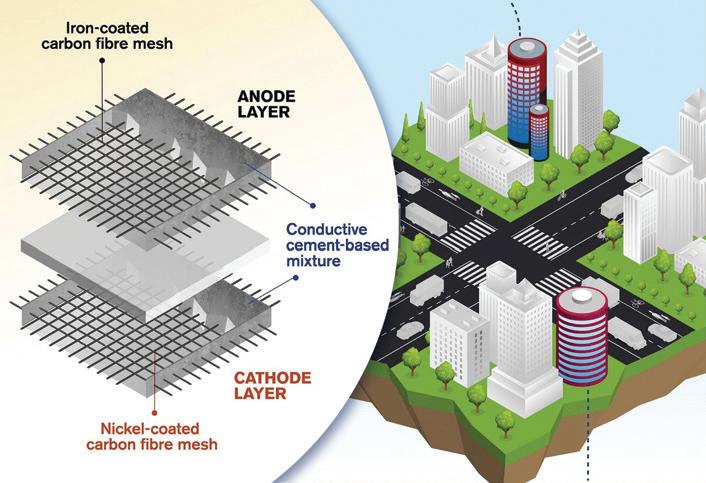
3 minute read
Nickel notables
CONTENTS
02 Case study no. 23 3D-printed bridge 03 Editorial Social nickel enabling social life 04 Nickel notables
Advertisement

06 In your pocket Mini capacitors 08 Mining electronic waste A new life for used metals 10 Vital nickel Vaccine production 12 Nickel The sociable metal
13 Nickel alloys Invar
14 Technical Q&A Buried stainless steel pipes 15 New publications 15 UNS details
16 LUMA Arles Tower Inspired by van Gogh
Nickel magazine is published by Nickel Institute
www.nickelinstitute.org
Dr. Hudson Bates, President Clare Richardson, Editor
communications@nickelinstitute.org
Contributors: Gary Coates, Jim Fritz, Richard Matheson, Geir Moe, Kim Oakes, Odette Ziezold
Design: Constructive Communications
Material has been prepared for the general information of the reader and should not be used or relied upon for speci c applications without rst securing competent advice. While the material is believed to be technically correct, Nickel Institute, its members, sta and consultants do not represent or warrant its suitability for any general or speci c use and assume no liability or responsibility of any kind in connection with the information herein.
ISSN 0829-8351
Printed in Canada on recycled paper by Hayes Print Group
Cover: iStock©co eekai Stock image credits: pg. 3 iStock©Orbon Alija pg. 6 Shutterstock©OlegDoroshin pg 8. iStock©Lya_Cattel, pg 9. iStock©pagadesign pg.10 iStock©SDI Productions, pg.11 iStock©Drazen Zigic, pg. 12 iStock©maki_shmaki
NICKEL
NOTABLES


More power to concrete

Turn an apartment into a giant battery? Researchers Tang and Zhang at Chalmers University in Sweden have developed a prototype for a rechargeable, cement-based battery. The breakthrough involved embedding a concrete mix with short carbon fibres, an iron-coated mesh of carbon fibre, and mesh coated in nickel, using iron for the anode and nickel for the cathode. Research yielded an average energy density of 7 watt-hours per square meter. Low compared to commercial batteries, but through sheer volume, the technique is capable of storing and delivering a substantial amount of energy. Concrete is the world’s most widely used construction material, so when the cement-based battery is incorporated into buildings, bridges, and sidewalks in the future, it could be a construction game-changer towards greater sustainability.
Branching out in China
It’s a futuristic forest where whimsical architecture meets technological ingenuity. Located in Nanjing, China and part of the Jiangsu Garden Expo, the Future Garden features 42 stainless steel trees that act as umbrellas supporting the roof. Each tree is the same and they are all connected to one another. The acrylic panel is the top of the lotus leaf, the first of its kind in the world. The area, transformed from reclaimed mines and an abandoned cement plant, is now a delight to the eye, despite its complex ground conditions and construction challenges. It was successfully completed using 1,000 tons of nickelcontaining Type 316L (UNS S31603) stainless steel.


Flying electric
In a significant step towards greener skies, ElectricAir's founder Gary Freedman recorded the world’s longest flight over water by a pure electric plane, making a 40-minute journey across the New Zealand’s Cook Strait. Powered by two nickel-containing lithium battery packs to drive the electric motor, they can last up to 90 minutes and be recharged in under an hour. The solo flight came 101 years after the first conventional aircraft flight over the strait that separates New Zealand’s two main islands and timed to coincide with the opening of the October 2021 U.N. Climate Summit in Scotland. “The start of radical change.” Freedman says, “Bigger, longer-range electric aircraft are on the way and are ideal for short haul routes.”
Measuring the sweet in sweat
Scientists from Pennsylvania State University have published the details of an innovative, noninvasive, low-cost sensor that can detect glucose in sweat, in Biosensors and Bioelectronics. First constructed with laser-induced graphene (LIG), it was “not sensitive to glucose at all”. They then chose nickel because of its “robust glucose sensitivity.” Attaching the reusable device to the arm one hour and three hours after a meal, the subject performed a brief workout. While the concentration of glucose in sweat is about 100 times less than in blood, the new device accurately measured the glucose as verified by commercially available monitors. “We want to work to see how we can apply this technology for daily monitoring of a patient,” Cheng said.









